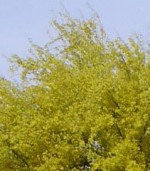 This small deciduous tree to large shrub is native to the Sonoran desert of southeastern California, Arizona, and Mexico where it grows in intermittent streams, arroyos, and riverbanks. It is a member of the legume family, Fabaceae, that also includes Acacia, lupines, and kudzu. The trunk, branches, and scale-like leaves are blue green and both carry out photosynthesis until the leaves drop in the summer leaving food making to the trunk and branches the rest of the year. The leaves are pinnately compound with two to six leaflets. In early spring two to four inch long clusters of showy yellow pea-like flowers appear and are followed in summer by thin, 2-3 inch long bean-like pods that provide food for birds and small rodents. Plants may be used as a screen, a specimen or patio tree and excellent in xeric landscapes because of their toughness and drought tolerance.
This small deciduous tree to large shrub is native to the Sonoran desert of southeastern California, Arizona, and Mexico where it grows in intermittent streams, arroyos, and riverbanks. It is a member of the legume family, Fabaceae, that also includes Acacia, lupines, and kudzu. The trunk, branches, and scale-like leaves are blue green and both carry out photosynthesis until the leaves drop in the summer leaving food making to the trunk and branches the rest of the year. The leaves are pinnately compound with two to six leaflets. In early spring two to four inch long clusters of showy yellow pea-like flowers appear and are followed in summer by thin, 2-3 inch long bean-like pods that provide food for birds and small rodents. Plants may be used as a screen, a specimen or patio tree and excellent in xeric landscapes because of their toughness and drought tolerance.
Type: Deciduous small tree or large shrub
Outstanding Feature: Flowers; green winter branches and twigs
Form: Somewhat rounded and spreading
Growth Rate: Moderate
Bloom: Two to four inch long clusters of showy yellow pea-like flowers in spring
Size: 20-25’ H x 25-30’ W
Light: Full sun
Soil: Average, well-rained, neutral to alkaline; very drought tolerant
Hardiness: Zones 8-10
Care: Prune lower branches to raise the crown base height for more useful and attractive plant.
Pests and Diseases: Root borers
Propagation: Seed